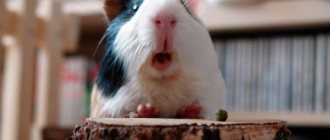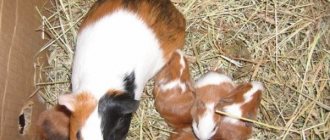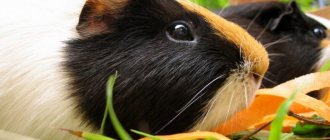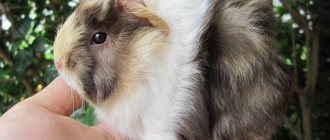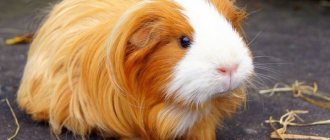Guinea pigs, or cavies, are charming decorative rodents that cannot but cause affection. They immediately attract attention with their funny behavior and are often included in the list of candidates for the role of a pet. And since these rodents are far from ideal, it is better to analyze the main pros and cons of guinea pigs before purchasing.
How many pigs do you need to be completely happy?
Keeping a guinea pig alone should be considered animal cruelty. A lonely pig moves little, eats more and develops behavioral disorders. Such animals even live significantly less than happy relatives in the group.
If you are not ready to keep two pigs, don’t get one. A lonely animal will never be happy; guinea pigs are too determined to communicate with their own kind. After all, in nature these animals live in colonies.
Even if the pig is “friends” with the owner, with the cat, with the dog, communication with another pig will not replace it. It’s worth watching the animals that live together to understand the difference: they play, groom each other’s fur, sleep in each other’s arms, and chirp.
It’s not too late to add relatives to an adult guinea pig. Some owners don't do this to keep their pet tame and friendly. Or more correctly, painfully dependent on rare human attention. There is no need for selfishness: pigs in a group are much more interesting to watch, and they will remain tame if you devote time to them every day.
Is it worth getting an exhibition copy?
When choosing a guinea pig, many people want to purchase an exhibition specimen of a rare breed, without thinking at all about the responsibility that they will have to take on. In addition, the cost of an exhibition rodent will also be much higher than a regular one.
In addition to financial expenses, the future owner of a guinea pig has a number of responsibilities:
- joining the breeders club;
- participation in exhibitions;
- selection of a partner for mating;
- daily animal care.
If the owner of a purebred individual plans to breed, he will either have to find a suitable pair or buy one.
The appearance of offspring will require more space and time, which may make the breeder want to find a new home for a significant part of his animals. Finding people willing to place guinea pigs in their apartment is not easy. This is due to the high fertility of these rodents.
All breeds can be divided into four types:
- long-haired;
- rosette;
- smooth-haired;
- bald.
When purchasing an exhibition specimen of a long-haired breed, it is important to understand that this animal will require daily care for its coat, which the owner will have to comb.
There is no need to hope that this painstaking task can be entrusted to the children for whom the animal was purchased. Without proper care, your pet's fur will quickly become matted, turning your pig's life into a real nightmare.
Breeds with smooth coats are most suitable for beginner breeders. These individuals are easy to care for and have a more stable immune system, due to which diseases occur much less frequently.
Features of the alpaca breed.
How much space does a guinea pig take up: cage arrangement
If you want to get a pig because there is not enough space in your apartment for a cat or dog, give up this idea. A guinea pig takes up more space than the largest cat and makes more noise.
You cannot keep a pig in:
- Aquarium/terrarium;
- Closed cage "dune";
- Hamster cage;
- Multi-tiered high cage for birds, chinchillas, rats.
The ideal option is an enclosure, but it is rarely built in an apartment. The cage should be one-story, 120-150 cm in length to accommodate 2-3 animals. The bigger the better, but even a spacious cage does not satisfy the need for movement, and rodents need to be allowed out of the cage for a walk (6 hours a day).
It may seem that a large cage requires a lot of filler, but in fact this is not the case: you will have to change the bedding less often than in a small cage. Bedding options:
- Paper filler;
- Wood or corn pellets combined with sawdust;
- Sawdust.
The filler should be applied in a thick layer (5 cm), changing as it gets dirty. Under it, on the bottom, you can lay an absorbent diaper. Abroad, fleece fabric is often placed on top of the filling. Fleece allows urine to flow downwards, drying instantly, and solid feces are easy to clean up. This type of bedding needs to be washed regularly.
You cannot keep your pig on a wire rack so that the excrement falls down. The grill damages the paws, causing pododermatitis.
Tunnels, houses, bridges made of ceramics or wood are placed in the cage. There are special toys for pigs - pipes made of hay, wicker balls made of straw. You can hang fabric hammocks or set up beds, but they will have to be washed often.
Prohibited:
- wheel (any size);
- walking ball;
- plastic things.
How to choose a breed
All breeds can be divided into 2 types:
Short-haired and long-haired
Shorthair
- Self - these guys are painted in one color. Moreover, the paws and ears are also of a uniform shade.
- Satin - with a soft, glossy skin. The color is usually uniform, but there are also mixtures.
- Bicolor - two colors on the coat
- Tri-color - three different colors have a border and do not mix with each other.
- Dalmatians are white with black spots. The muzzle and paws are usually always black.
- Himalayans - these animals are white, with the exception of black paws and the nose area.
- Agouti is a dark coat with light tips.
- Teddy – They have wavy and short fur.
Longhair
- Sheltie - long hair grows from the muzzle down.
- Peruvian - long hair grows towards the muzzle and falls over the eyes.
- Texel - long curly hair grows from the muzzle.
- Alpaca - long curly hair grows towards the muzzle.
What to feed your guinea pig
Basic rule: food is given without restriction. Pigs eat all the time! The basis of the diet is good quality hay, and in summer – grass. Hay is placed in the cage daily, removing yesterday's hay. Hay is needed around the clock, even if you feed green grass.
In addition to hay, an adult pig is given 150-300 g of vegetables and herbs per day, dividing the portion into several doses to avoid digestive upset. In summer they provide fresh branches with leaves.
Guinea pigs are not hamsters and do not eat grain. They do not need to be given industrial dry food at all, unless we are talking about young animals or pregnant females. When it is necessary to gain weight or increase the caloric content of the diet for another reason, food is given, but not ad libitum. The food should be for guinea pigs.
Additional treats:
- Herb seeds: fennel, dill, anise, dandelion, fescue, amaranth.
- Flaxseed or non-roasted sunflower seeds, but not all the time.
- Pet stores offer pressed hay baskets and dried plant roots (dandelion).
Fresh water is poured into a heavy ceramic bowl, and if an automatic drinking bowl is used, it is hung at muzzle level so that the pig does not have to lift its head.
Don't give pigs:
- Products of animal origin, including those containing milk.
- Sweet foods: chocolate, honey, sugar, confectionery, dried fruits, store-bought treats for rodents.
- Stone fruits (peaches, apricots, plums, cherries) and exotic (pineapple, banana, citruses).
- Plants that cause fermentation: legumes, cabbage.
- Onions, radishes, radishes, rhubarb.
- Potato.
- Cereals (rice, buckwheat and others).
- Flour (baked goods, pasta).
Anti-stress effect
In our difficult times, many people experience incredible fatigue caused by the need to deal with stress every day. And here everyone finds the necessary outlet for themselves. Some are trying to console themselves by going out with friends, others are rushing to get pets. Guinea pigs evoke many positive emotions.
These are real powerful antidepressants. If such an animal is next to you, you will not be sad
Instead of buying various sedatives, you should pay attention to the prospect of having an animal such as a hamster or guinea pig at home. Pros and cons will help you make your choice
Most often, as a result of this action, a person begins to feel additional meaning in all his daily activities. Having a little furry friend at home greatly helps fight bad moods and various fears.
Cons of guinea pigs: 7 fly in the ointment
There is nothing worse than disappointment from a pet. A responsible person will continue to care for the animal, but these responsibilities will not bring joy. When such an animal is gone, the owner will feel both shame and relief, but not sadness. An irresponsible person will simply get rid of an inconvenient pet, and it’s good if he finds good hands for it and does not throw it in the trash.
Before getting a guinea pig, you need to learn about the characteristics of these animals, which not everyone will like:
They make a lot of noise
Guinea pigs not only constantly chew on something, they love to dig into the litter and run around the cage. And they are capable of making a huge number of sounds. Pigs whistle shrilly, squeak, squeal, grumble, chirp, and grind their teeth.
Owners find begging to be a particularly annoying habit. As soon as you slam the refrigerator door or walk past the cage, the pig starts screaming, demanding attention or a treat.
If there are several pets, then they will talk to each other out loud, whistling about something of their own. Talkativeness is the main difference between pigs and other rodents and rabbits.
They litter and get dirty
Guinea pigs love to dig around the bedding, scattering sawdust, hay, food and their own poop around the cage. Daily housekeeping will be required to keep the room clean. In addition to cleaning around the cage, you need to regularly change the filler.
It is impossible to train a guinea pig to a litter box; it eats and poops constantly. Therefore, when you release an animal for a walk, expect to find traces of its activity everywhere.
They are afraid of people, but cannot stand loneliness
At the genetic level, the pig suspects that everyone wants to eat it. Despite the fact that these animals are not aggressive, you should not expect friendliness, trust and a desire to communicate from them either. You will have to spend time accustoming the pig to your hands. A pet can be wary of people for a long time, hiding in the house every time they try to pick it up.
However, under no circumstances should you leave the pig alone. They literally waste away and die of boredom. Ideally, you need communication with relatives. That is, in order for the pig to be happy, you must purchase two or more same-sex animals and paw them less, watching the idyll from afar.
May cause allergies
If one of your family members is allergic to cats or other animals or prone to asthma, you cannot hope that they will not be allergic to a rodent. You can check the reaction to an allergen in guinea pigs in the laboratory, or even more reliably - talk to friends or a breeder for some time with the animals.
Not only the pigs themselves can irritate the respiratory tract, but also dust from sawdust and hay, which must be present in the cage 24 hours a day.
Expensive veterinary care
These rodents have fragile health and are difficult to treat. Infectious diseases in almost 100% of cases end in death, a draft threatens pneumonia, open sunlight - heat stroke. Most often, pigs get sick from improper feeding: forbidden food causes bloating, diarrhea, and poisoning.
An ordinary veterinarian is unlikely to be able to help: the body of guinea pigs is fundamentally different from that of cats and dogs. Find out in advance whether there is a rodent specialist in your city - a rodentologist (ratologist). If not, contact experienced guinea pig breeders.
Seeing a rodentologist is an expensive pleasure. The most common reason for contacting such a specialist is the pathological growth of teeth in mumps (not only the incisors, but also the chewing teeth located deep in the mouth). If teeth are not properly ground down, they are filed under general anesthesia.
Primitive behavior
A guinea pig cannot be trained like a dog. You shouldn't expect too much from them at all. The most sociable rodents can respond to their name, but teaching them commands is a hopeless idea. They also do not take any active part in games, preferring to simply run around the room and chew everything they can get their teeth on.
Coprophagia
Like rabbits, pigs eat their own droppings. Not those solid cylinders that they leave on the litter, but the “primary” liquid, underdigested feces. The pig catches it directly from the anus, curling up into a ball.
For pigs this is absolutely normal and necessary, that’s what Mother Nature came up with. But some people find this feature off-putting.
Brief information and history
Its attractive face, calm nature, affectionate disposition and quirky clumsiness make the guinea pig a desirable pet for many children. The small size of the animal allows it to be kept even in a small apartment. Financially, a pig is also more profitable than many other pets, since it eats little, accessories and a house for a rodent are inexpensive. But not everyone decides to purchase a guinea pig, fearing difficulties in caring for it.
The guinea pig is a miniature domesticated member of the pig family. The guinea pig can also be found under another name - “Guinea pig” or “Kevi”. Interestingly, the animal has nothing to do with pigs, wild boars and other representatives of the pig family, as well as with representatives of marine life. It is unlikely that they ever lived in Guinea; it is believed that the birthplace of modern guinea pigs is Peru.
The animal got a funny name in Russia, where it was delivered by sea. And the funny, elongated face resembled newborn piglets. This is where the name “Overseas Pig” came from, which over time transformed into Guinea Pig.
Kevi
Pigs began interacting with people around the 5th century BC. Aboriginal tribes domesticated small, fleshy animals for the purpose of breeding and eating them. Particularly touching individuals were kept as pets. Today, no one eats guinea pigs anymore, and their main purpose is to please their owners.
The lifespan of these small rodents largely depends on the conditions of their detention. On average, they can live from five to eight years. Among guinea pigs you can also find centenarians who lived a long life, fifteen years long. It is extremely difficult to achieve such a result; this is the exception rather than the rule, due to the genetic characteristics of the animal.
Summary: whether or not to get a guinea pig
Guinea pigs make wonderful pets. It's a pleasure to watch them. But you shouldn’t have them if:
- You are not ready to adopt two or more pigs at once;
- Get a guinea pig instead of a cat or dog;
- Are you going to keep the animal in a tight cage?
- Spend little time at home.
Guinea pig: keeping and caring for is a troublesome task; many people believe that caring for a cat is much easier. To prevent things from happening, as in the well-known saying “the woman had no worries, the woman bought a piglet,” assess your capabilities in advance.
If you provide a pig company with decent living conditions, the animals will delight you for many years with their cheerfulness, interesting habits and good health. Write in the comments about your pets!
If this article was helpful, please support the author HERE. You can also purchase a fictional story about the work of veterinarians “Dachshund of Fate” using the link.
Paired content
This is also a difficult point that needs to be taken into account in a timely manner.
Guinea pigs should only be kept in same-sex pairs. If an animal is kept alone, rest assured that it will soon become ill and die. Guinea pigs are incredibly social rodents. They need communication just like air. Breeding them is quite difficult; the offspring are often born unhealthy. For this reason, you need to put a relative of the same sex in the same pig's cage. It is better to do this soon, as soon as you have a pig, or buy two pets at once.
Accordingly, all expenses double. If a person is already not rich, then it will be difficult for him to allocate funds for the maintenance of his pets.
In favor of the chinchilla
Chinchillas live on average from six to ten years. Very active and friendly, they love a lot of space. They are often allowed to walk around the house. They are housed in large metal cages with a plastic tray, often homemade. The disadvantages include a nocturnal lifestyle, it is at this time that they are most active. They sleep during the day or have lethargic behavior. For this reason, the chinchilla is not suitable for everyone, since at night it is quite noisy and interferes with sleep.
Many animals do not like being alone and need a partner. Chinchillas are not like that; they can be kept alone. Although she will not refuse a partner, since she is very sociable. It will quickly become a good companion and friend for children. In general, there are advantages to supporting one person and an entire family. The behavior is very interesting to observe from the outside, especially when they play together. The male and female during the mating season is a separate issue; they constantly chase each other around the cage or sit next to each other and watch each other.
Chinchillas are distinguished by their intelligence and ingenuity; they quickly understand what’s what and how to behave. Easy to toilet train. Some individuals are very cunning; when they need something from a person, they sit in the corner and look at him. This behavior quickly bears fruit.
You need to feed your chinchilla a variety of foods: nuts, vegetables and fruits, special food, hay, and even food from our table. The animal must have access to fresh water. Since they love to swim, a special bathing suit is left in the cage once a day for an hour.
There are several main advantages of keeping a chinchilla at home:
- Easy care;
- Rare diseases;
- No unpleasant odor;
- They make contact easily with people and animals;
- Easily tamed;
- Are subject to training;
- They never bite;
- Beautiful appearance;
- They have an interesting character and are able to quickly cheer up;
- They live 6–10 years, some individuals live up to 20.
The last fact can be attributed to pros and cons at the same time. Not everyone wants to take responsibility for an animal for a third of its life.
There is one interesting character trait: they are able to be offended and show it. If you don’t take him for a usual walk or entrust the care to other people, you can see that the pet is offended. Cheerfulness disappears, often even stops taking food from hands. But it’s enough to sit next to you and apologize, and she immediately understands everything and becomes active and friendly again.





